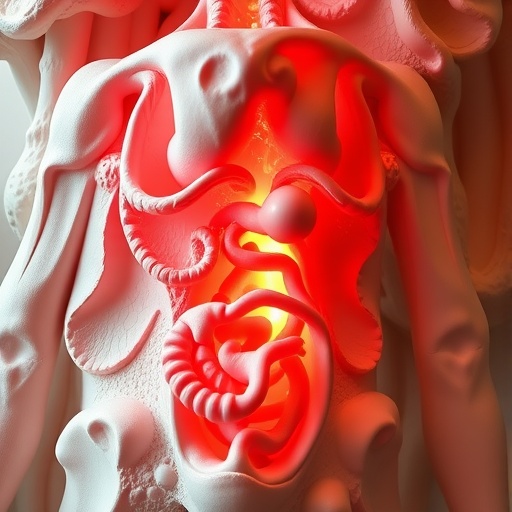In a groundbreaking study emerging from Syracuse University, researchers have unveiled a compelling new perspective on the forces that govern organ development. Traditional scientific understanding has long credited the intricate biochemistry of genes and proteins with directing the formation and shaping of organs during embryonic development. However, this innovative research shines a spotlight on the overlooked significance of physical and mechanical forces, which may be just as crucial as biochemical signals in sculpting the structures within a developing organism.
At the heart of this exploration lies Kupffer’s vesicle (KV), a transient, fluid-filled, balloon-like structure found in the embryos of zebrafish. Although diminutive and existing only briefly, KV plays a pivotal role in establishing the body’s symmetry and guiding the spatial arrangement of internal organs. The research team focused on how KV’s movement within the surrounding tissue generates mechanical forces that actively influence its own shape as well as the architecture of adjacent tissues.
The study reveals that KV slowly propels itself through the tailbud tissue of the zebrafish embryo, driven by the internal, self-generated forces of the constituent cells. This gradual journey is anything but inconsequential; as KV traverses through the tailbud, it exerts pressure on the surrounding tissues, instigating a cascade of physical responses. Prior to this research, biologists often dismissed such tissue movements as too slow or subtle to be of significant developmental consequence. Nevertheless, the findings here overturn that notion by demonstrating that even slow, steady cellular flows can drive powerful mechanical forces essential for correct organ morphogenesis.
The Soxhlet-like gradient of tissue stiffness surrounding KV creates a unique mechanical landscape. On the anterior side, the tissue behaves as a viscous medium resembling honey, capable of slow flow, whereas the posterior side comprises a nearly solid, rigid matrix. KV’s transit through these heterogeneous environments induces differential forces that shape its form. These forces, though operating at minute scales and slow speeds, are surprisingly robust, unveiling a novel layer of complexity in developmental biology where mechanics intertwine with molecular signaling.
Key to deciphering these biomechanical phenomena was the integration of mathematical modeling, live imaging, and precise physical manipulations. The researchers constructed computational frameworks that simulated the interactions between KV and the variably stiff surrounding tissues. These models accurately predicted how forces generated by tissue flows could deform KV, prompting experimental confirmation through cutting-edge laser ablation techniques. By disrupting mechanical forces in living embryos, the team observed alterations in KV’s morphology precisely as anticipated by their simulations, affirming the validity of their mechanical hypotheses.
This convergence of biophysics and developmental biology introduces an emergent paradigm where organogenesis is a choreography of both chemical instructions and physical forces. Dr. M. Lisa Manning, the William R. Kenan, Jr. Professor of Physics and founder of the BioInspired Institute, emphasizes that these mechanisms do not operate in isolation. Instead, mechanical interactions and biochemical signals synergistically orchestrate the complex patterning processes that culminate in functional organs, a realization that could reshape future biological research.
Beyond zebrafish embryos, these insights carry profound implications for understanding human development and disease. As organ formation shares conserved principles across vertebrates, the mechanical forces demonstrated here may also influence human morphogenesis. For instance, aberrations in tissue mechanics during fetal development might underpin certain congenital disorders or malformations, suggesting new avenues for early diagnosis or therapeutic intervention focused on biomechanical environments.
Moreover, the implications extend into regenerative medicine, where creating artificial organs or tissue grafts demands precise control of growth and form. The ability to harness and replicate these mechanical forces offers promising strategies to improve organoid cultures and tissue engineering. It opens doors to refining how cultured cells organize into three-dimensional structures with correct spatial functionality, vital for transplantation and repair technologies.
Intriguingly, this research also tangentially touches on cancer biology, as dynamic forces within tissues influence tumor progression and metastasis. Dr. Manning notes ongoing collaborative efforts exploring how the biomechanical forces that shape normal organs could similarly impact cancer tumors. Understanding these physical cues could potentially lead to innovative treatments targeting the mechanical milieu of tumors, disrupting cancer cell growth or dissemination.
This study marks an important milestone in our comprehension of developmental processes, highlighting the necessity of multidisciplinary approaches that bridge physics, biology, and computational science. It showcases how embracing the physical sciences enriches our grasp of living systems, pushing beyond genetic and molecular narratives to embrace the tangible forces at work within tissues.
The full details of the investigation are documented in the journal Proceedings of the National Academy of Sciences, presenting a compelling case for reevaluating the role of mechanics in embryonic development. By demonstrating how the slow but persistent motion of tissues generates shaping forces at the micro-scale, the research challenges longstanding dogmas and points to a future where biomechanical engineering complements genetic and molecular interventions in medicine.
In conclusion, the synergy between mechanical forces and biochemical signals revealed by this study opens new horizons for both basic biology and clinical science. It suggests a more holistic view of morphogenesis, where physical interactions complement genetic blueprints to craft the complexity of life. As these concepts permeate regenerative medicine, developmental biology, and cancer research, they promise to catalyze innovative strategies that harness mechanics to heal and build biological form.
Subject of Research: Organ development and mechanical forces shaping embryonic structures
Article Title: (Not explicitly provided in the content)
Web References:
References:
- Manna, R.K., Hehnly, H., Amack, J., Retzlaff, E., Manning, M.L. et al. (2024). Physical forces drive shape change in Kupffer’s vesicle during zebrafish embryogenesis. Proceedings of the National Academy of Sciences. DOI: 10.1073/pnas.2418111122
Image Credits: Syracuse University
Keywords:
Biophysics, Cell Biology, Molecular Biology, Molecular Evolution, Chemical Biology, Structural Biology, Life Sciences




